
Two women are spreading out the sheets after washing them on the stone while chatting about the latest news in the village. In front of them, a small group is enjoying a piece of bread with red and green mojo sauce and some wrinkled potatoes, lying at the edge of the road and seeking some shade. In a nearby house, a woman carries a jug full of milk that she is trying to sell to passersby in the area. It could be the scene of any Canarian town at the beginning of the last century. However, this is what happened this weekend in Santiago del Teide, which offered neighbours and visitors the XVII edition of the barter Across the Summit, a representation in which several dozen locals participated to keep the traditions of the Archipelago alive.
Clad in the attire that peasants used at that time, the group of participants played the roles of chieftains, goatherds, witches, pig farmers, milkmaids or bakers, among many other occupations depicted in this activity that is beginning to attract the interest of tourists. In this way, not only did the participants traverse the final stretch of the route playing their roles, but they were also accompanied by several curious foreigners who did not want to miss any details of the practices of yesteryear in Canary Islands and who will surely pass on these actions to their own countries.
This activity organized by the Town Hall of Santiago del Teide for several years now, pays tribute to the Canarian generations that traversed the roads and paths of the Archipelago in search of family sustenance centuries ago. In this activity, bartering became an essential practice that ensured that neighbours had everything they needed in their homes after harvesting. This practice also significantly influenced the social relationships that were established as a result of these commercial transactions, connecting people from different areas of the island.
The representation of Across the Summit took up almost the entire day for its participants, who set off at around nine in the morning from the hermitage of San Francisco in the neighbourhood of La Montañeta, in Garachico. They then headed to San José de Los Llanos, in El Tanque, and the journey culminated, after two in the afternoon, at the public square of Santiago del Teide, where after staging the barter, awards were presented to the participants and the Bentahod group performed. Additionally, attendees could enjoy a stew amidst a totally festive atmosphere that filled the historic centre of the municipality with people, making it practically impossible to find parking in the middle of the morning.
The Protagonists
[–>
Everyone in the historic centre of Santiago del Teide knows María Candelaria Martín as Lala. She has been participating in the reenactment of the barter for many years, but this time she had to shelter under the shade of a tree and wait for the activity to reach the surroundings of the square to join, as a spike in blood pressure the day before forced her to be absent from this edition. Despite this, she did not want to miss this appointment and, dressed in her checkered scarf, a straw hat, and a smoking pipe, she tried to exchange almonds and carrots with the other participants in the reenactment. Despite the usual heat present in this barter and the length of the journey, Lala acknowledged that “each year seems too short to me” because this activity “has something very special, which is the recovery of ancient life, something we should never forget,” she declared moments before the entourage reached the end of the route.
Vicky Clemente positioned herself a bit further along the path and sat beside a wall to mend some sheets, although her daughter, Rosana González, had to help her thread the small needle on more than one occasion. The 14-year-old girl took charge of distributing freshly peeled almonds among the attendees and was completely delighted with this initiative, in which she has been participating since she was nine years old.
Paco arrived from the Netherlands, a tourist who moved to Tenerife a few months ago, and through the dance school of Santiago del Teide, he learned about this initiative which he decided to join this year. While Vicky was sewing the sheets, he peeled some almonds as if he were a local and defended the Canarian traditions, totally different from those of his country, but which must be preserved for future generations to also know them.
Eugenia Gil also belongs to the dance school of Santiago del Teide and went with some classmates to this initiative, in which they have been participating for some years because “we cannot allow traditions to be lost.” She said this while seated on a blanket where she had placed a pot full of wrinkled potatoes while a companion mended a tablecloth and the men discussed how their day in the mountains had gone.
[–>
This initiative also provided funny and unforgettable moments, like when one of the participating neighbours, while washing some sheets, pretended to give birth to her eighth child. A doctor from the era came to the scene and did not hesitate to examine her on the side of the road. While a group of cobblers tried to exchange new boots for some food products, a group of women and a priest prayed on their way to the church, where time stood still once again to bring the oldest traditions of the Canary Islands to the present.
















